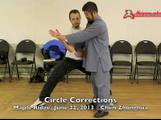Author: Chen Zhonghua Length: 55 min. In: English Year: 2010 Difficulty:4/5 At:Edmonton
Contents: 1. Introduction. 2. Differential in taiji. 3. Steadiness. 4. Energy movements. 5. Delayed gratification. 6. Detailed explanations. 7. Examples and experiments. 8. Weight differential. 9. Guided practice session.
The Energy Differential in Tai Chi Online Video Trailer
Previous post: 2011.5.6 DQS Taiji Seminars
Next post: Checking in with a question



{ 6 comments… read them below or add one }
Principle instead of technique is the ultimate in martial art and in self defence. A concerted study of this principle so it can be applied will enhance every technique.
After a recent, related discussion at the April – 2011 Maple Ridge workshop, I went back and watched this Energy Differential video again.
During the discussion at the Maple Ridge workshop, the topic of an airplane wing was compared to the concepts in this Energy Differential in Taiji video. It was noted that the top of an airplane wing is curved (arched) while the bottom is flat. There is a differential in the wing shape. The plane’s wings never changes shape, and are caused to interact with the air because of the airplane’s motor power. When the air is forced to travel over the top of the wing faster than it does across the bottom of the wing (because of the differential), it creates a huge lifting power. It is big enough to lift the plane off the ground!
In contrast to the airplane wing, when we are in contact with an opponent, we supply the power to change our body shape to create a differential. When we are able to hold other key body parts steady, while creating a differential, we can cause the resulting power to be transmitted to our opponent. One example in this video would be in push hands where the upper body is held steady while fluctuating the lower body. This video has helped me realize that without steadiness (while creating a differential), no useful power can be generated.
“Once you understand the principle, whatever you do is correct.”
This is an really great video describing several different methods of creating a differential..in experimentation with it I’ve been mainly trying to match at the point of contact and sort of pour myself into the opponents empty space around him. One really interesting thing that happens is that often times i don’t even have to add anything once i’m in..but the sheer closeness of the situation causes the opponent to power himself out, once a certain point is reached. Just sort of trying to match the space…beyond the matching at the physical contact level. It’s like a subtle psychological trick…people are just uncomfortable it seems being this close. It’s very unusual but really awesome!
I should add that it I can only do it under slow and low power situations…. if it was fast and with more power i’m quite sure i cannot reproduce it…..gradually…gradually…maybe one day i will be able to.
after further experimentation…i’ve realized i am adding by squeezing towards the line (creating a differential by lengthening the lead end of it,as the opponent struggles against it, it feels like they are pushing themself out) sorry for the confusion…would it be correct to say we don’t move so we can measure, we measure so we can match, we match to neutralize, and neutralize to find opportunity to create a differential?